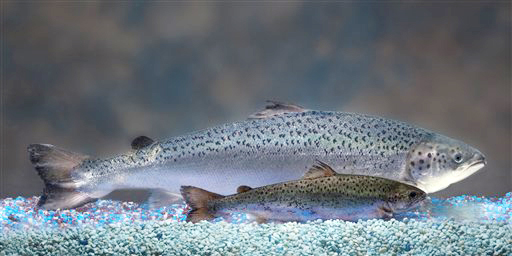WASHINGTON — Salmon that’s been genetically modified to grow twice as fast as normal could soon show up on your dinner plate. That is, if the company that makes the fish can stay afloat.
After weathering concerns about everything from the safety of humans eating the salmon to their impact on the environment, Aquabounty was poised to become the world’s first company to sell fish whose DNA has been altered to speed up growth.
The Food and Drug Administration in 2010 concluded that Aquabounty’s salmon was as safe to eat as the traditional variety. The agency also said that there’s little chance that the salmon could escape and breed with wild fish, which could disrupt the fragile relationships between plants and animals in nature. But more than two years later the FDA has not approved the fish, and Aquabounty is running out of money.
“It’s threatening our very survival,” says CEO Ron Stotish, chief executive of the Maynard, Mass.-based company. “We only have enough money to survive until January 2013, so we have to raise more. But the unexplained delay has made raising money very difficult.”
The FDA says it’s still working on the final piece of its review, a report on the potential environmental impact of the salmon that must be published for comment before an approval can be issued. That means a final decision could be months, even years away. While the delay could mean that the faster-growing salmon will never wind up on American dinner tables, there’s more at stake than seafood.
Already, biotech scientists are changing their plans to avoid getting stuck in FDA-related regulatory limbo. “The story of Aquabounty is disappointing because everyone was hoping the company would be a clear signal that genetic modification in animals is now acceptable in the U.S.,” said Professor Helen Sang, a geneticist at the University of Edinburgh in Scotland who is working to develop genetically modified chickens that are resistant to bird flu. “Because it’s gotten so bogged down – and presumably cost AquaBounty a huge amount of money – I think people will be put off.”
AGAINST THE CURRENT
The science behind genetic modification is not new. Biotech scientists say that genetic manipulation is a proven way to reduce disease and enrich plants and animals, raising productivity and increasing the global food supply. Genetically modified corn, cotton and soybeans account for more than four-fifths of those crops grown in the U.S., according to the National Academies of Sciences.
But there have always been critics who are wary of tinkering with the genes of living animals. They say the risk is too great that modified organisms can escape into the wild and breed with native species. Not that we don’t already eat genetically altered animals. Researchers say the centuries-old practice of selective breeding is its own form of genetic engineering, producing the plumper cows, pigs and poultry we eat today.
Aquabounty executives say their aim is to make the U.S. fish farming industry, or aquaculture, more efficient, environmentally friendly and profitable. After all, the U.S. imports about 86 percent of its seafood, in part, because it has a relatively small aquaculture industry. Aquaculture has faced pushback in the U.S. because of concerns about pollution from large fish pens in the ocean, which generate fish waste and leftover food.
Aquabounty executives figure that the U.S. aquaculture industry can be transformed by speeding up the growth of seafood. The company picked Atlantic salmon because they are the most widely-consumed salmon in the U.S. and are farmed throughout the world.
Using gene-manipulating technology, Aquabounty adds a growth hormone to the Atlantic salmon from another type of salmon called the Chinook. The process, company executives say, causes its salmon to reach maturity in about two years, compared with three to four years for a conventional salmon.
Aquabounty executives say if their fish are approved for commercial sale, there are several safeguards designed to prevent the fish from escaping and breeding with wild salmon. The salmon are bred as sterile females. They also are confined to pools where the potential for escape would be low: The inland pens are isolated from natural bodies of water.
And the company says that these pens would be affordable thanks to the fast-growing nature of Aquabounty’s fish, which allows farmers to raise more salmon in less time. Overall, the company estimates that it would cost 30 percent less to grow its fish than traditional salmon.
Send questions/comments to the editors.



Success. Please wait for the page to reload. If the page does not reload within 5 seconds, please refresh the page.
Enter your email and password to access comments.
Hi, to comment on stories you must . This profile is in addition to your subscription and website login.
Already have a commenting profile? .
Invalid username/password.
Please check your email to confirm and complete your registration.
Only subscribers are eligible to post comments. Please subscribe or login first for digital access. Here’s why.
Use the form below to reset your password. When you've submitted your account email, we will send an email with a reset code.